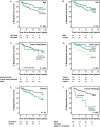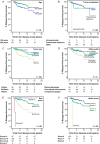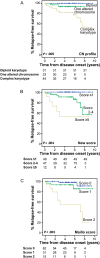Proposal for a new risk stratification classification for meningioma based on patient age, WHO tumor grade, size, localization, and karyotype
- PMID: 24536048
- PMCID: PMC3984558
- DOI: 10.1093/neuonc/not325
Proposal for a new risk stratification classification for meningioma based on patient age, WHO tumor grade, size, localization, and karyotype
Abstract
Background: Tumor recurrence remains the major clinical complication of meningiomas, the majority of recurrences occurring among WHO grade I/benign tumors. In the present study, we propose a new scoring system for the prognostic stratification of meningioma patients based on analysis of a large series of meningiomas followed for a median of >5 years.
Methods: Tumor cytogenetics were systematically investigated by interphase fluorescence in situ hybridization in 302 meningioma samples, and the proposed classification was further validated in an independent series of cases (n = 132) analyzed by high-density (500K) single-nucleotide polymorphism (SNP) arrays.
Results: Overall, we found an adverse impact on patient relapse-free survival (RFS) for males, presence of brain edema, younger patients (<55 years), tumor size >50 mm, tumor localization at intraventricular and anterior cranial base areas, WHO grade II/III meningiomas, and complex karyotypes; the latter 5 variables showed an independent predictive value in multivariate analysis. Based on these parameters, a prognostic score was established for each individual case, and patients were stratified into 4 risk categories with significantly different (P < .001) outcomes. These included a good prognosis group, consisting of approximately 20% of cases, that showed a RFS of 100% ± 0% at 10 years and a very poor-prognosis group with a RFS rate of 0% ± 0% at 10 years. The prognostic impact of the scoring system proposed here was also retained when WHO grade I cases were considered separately (P < .001).
Conclusions: Based on this risk-stratification classification, different strategies may be adopted for follow-up, and eventually also for treatment, of meningioma patients at different risks for relapse.
Keywords: SNP arrays; iFISH; meningioma; recurrence; risk stratification.
Figures




Similar articles
-
New classification scheme for the prognostic stratification of meningioma on the basis of chromosome 14 abnormalities, patient age, and tumor histopathology.J Clin Oncol. 2003 Sep 1;21(17):3285-95. doi: 10.1200/JCO.2003.07.156. J Clin Oncol. 2003. PMID: 12947064
-
Early recurrences in histologically benign/grade I meningiomas are associated with large tumors and coexistence of monosomy 14 and del(1p36) in the ancestral tumor cell clone.Neuro Oncol. 2007 Oct;9(4):438-46. doi: 10.1215/15228517-2007-026. Epub 2007 Aug 17. Neuro Oncol. 2007. PMID: 17704362 Free PMC article.
-
The cytogenetic relationship between primary and recurrent meningiomas points to the need for new treatment strategies in cases at high risk of relapse.Clin Cancer Res. 2006 Feb 1;12(3 Pt 1):772-80. doi: 10.1158/1078-0432.CCR-05-1480. Clin Cancer Res. 2006. PMID: 16467088
-
Meningiomas in children and adolescents: a meta-analysis of individual patient data.Lancet Oncol. 2011 Dec;12(13):1229-39. doi: 10.1016/S1470-2045(11)70275-3. Epub 2011 Nov 15. Lancet Oncol. 2011. PMID: 22094004 Review.
-
Proteomic data in meningiomas: post-proteomic analysis can reveal novel pathophysiological pathways.J Neurooncol. 2011 Sep;104(2):401-10. doi: 10.1007/s11060-010-0526-9. Epub 2011 Jan 11. J Neurooncol. 2011. PMID: 21222216 Review.
Cited by
-
Genetic/molecular alterations of meningiomas and the signaling pathways targeted.Oncotarget. 2015 May 10;6(13):10671-88. doi: 10.18632/oncotarget.3870. Oncotarget. 2015. PMID: 25965831 Free PMC article. Review.
-
Case-Based Review: meningioma.Neurooncol Pract. 2016 Jun;3(2):120-134. doi: 10.1093/nop/npv063. Epub 2016 Jan 13. Neurooncol Pract. 2016. PMID: 31386096 Free PMC article.
-
A gene expression signature predicts recurrence-free survival in meningioma.Oncotarget. 2018 Feb 15;9(22):16087-16098. doi: 10.18632/oncotarget.24498. eCollection 2018 Mar 23. Oncotarget. 2018. PMID: 29662628 Free PMC article.
-
[Retrocochlear diagnostics for acute hearing loss and successful therapy].HNO. 2024 Jan;72(1):44-50. doi: 10.1007/s00106-023-01351-5. Epub 2023 Aug 24. HNO. 2024. PMID: 37615685 Free PMC article. German.
-
TERT Promoter Mutations and Risk of Recurrence in Meningioma.J Natl Cancer Inst. 2015 Dec 13;108(5):djv377. doi: 10.1093/jnci/djv377. Print 2016 May. J Natl Cancer Inst. 2015. PMID: 26668184 Free PMC article.
References
-
- Mawrin C, Perry A. Pathological classification and molecular genetics of meningiomas. J Neurooncol. 2010;99:379–391. - PubMed
-
- Marosi C, Hassler M, Roessler K, et al. Meningioma. Crit Rev Oncol Hematol. 2008;67:153–171. - PubMed
-
- Yew A, Trang A, Nagasawa DT, et al. Chromosomal alterations, prognostic factors, and targeted molecular therapies for malignant meningiomas. J Clin Neurosci. 2013;20:17–22. - PubMed
-
- Stafford SL, Perry A, Suman VJ, et al. Primarily resected meningiomas: outcome and prognostic factors in 581 Mayo Clinic patients, 1978 through 1988. Mayo Clin Proc. 1998;73:936–942. - PubMed
Publication types
MeSH terms
LinkOut - more resources
Full Text Sources
Other Literature Sources
Medical
Molecular Biology Databases

